Ceramic coating offers a cutting-edge solution for vehicle protection, utilizing advanced nanotechnology to create a robust, chemical bond with the vehicle’s surface. This innovative coating shields against UV rays, harsh chemicals, and environmental contaminants, all while enhancing the vehicle’s appearance with a glossy finish. Unlike traditional wax, ceramic coatings repel water and dirt, making maintenance a breeze. However, achieving optimal results requires meticulous preparation and application. By understanding the benefits and proper care techniques involved, owners can significantly extend the lifespan of their coating. To uncover further insights into this transformative vehicle protection, exploring detailed aspects is essential.
Key Takeaways

- Ceramic coatings create a strong chemical bond, providing long-lasting protection against UV rays, contaminants, and harsh chemicals for vehicles.
- The application process involves meticulous preparation, including cleaning, decontamination, and paint correction for optimal adhesion and durability.
- These coatings enhance vehicle appearance with a glossy finish while simplifying cleaning by repelling water and dirt.
- Regular maintenance with pH-balanced cleaners prevents contaminant buildup and preserves the hydrophobic properties of the coating.
- Customer testimonials highlight the transformative effects of ceramic coatings, ensuring both aesthetic appeal and increased resale value for vehicles.
What Is Ceramic Coating?
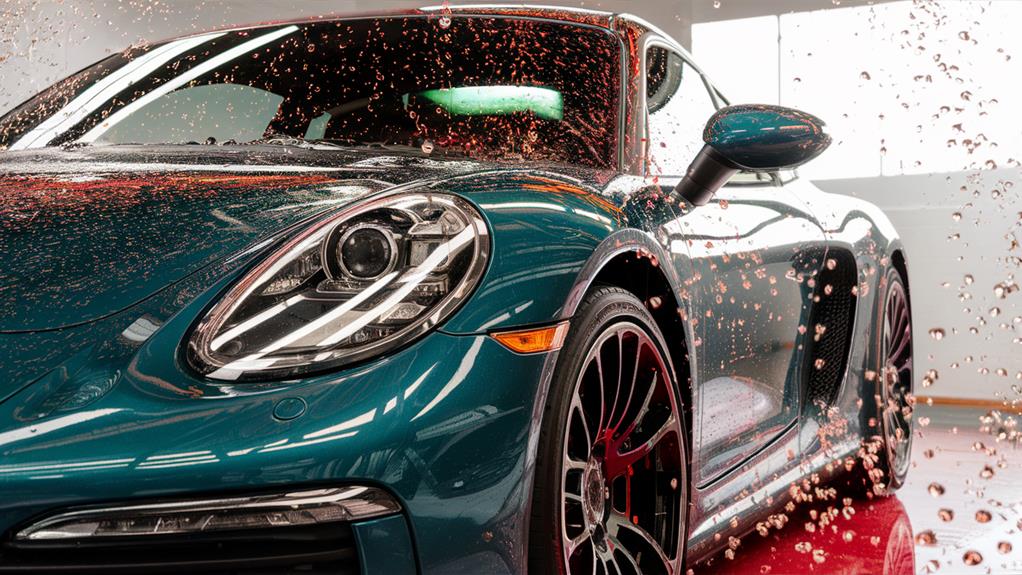
Ceramic coating is a cutting-edge protective layer applied to various surfaces, particularly vehicles. This advanced solution utilizes nanotechnology to create a strong bond with the surface, resulting in a hydrophobic effect that repels water and contaminants. Unlike traditional wax or sealants, ceramic coating offers long-term durability, often lasting several years with proper maintenance.
One of the most significant advantages of ceramic coating is its ability to provide environmental protection. It shields surfaces from harmful UV rays, preventing oxidation and fading caused by sun exposure. Additionally, it guards against harsh chemicals, bird droppings, tree sap, and road grime, which can damage a vehicle’s finish over time.
The application process involves meticulous preparation to ensure optimal adhesion, followed by the careful layering of the coating. Once cured, the ceramic coating forms a resilient barrier that enhances the vehicle’s appearance while simplifying cleaning. Car enthusiasts and everyday drivers alike appreciate how this innovation not only elevates the aesthetic appeal of their vehicles but also offers peace of mind regarding long-term maintenance. Ultimately, ceramic coating represents a smart investment in vehicle protection, blending functionality with advanced technology.
How Ceramic Coating Works
When applied to a surface, a ceramic coating creates a remarkable chemical bond that transforms the way it interacts with the elements. This bond is formed through a unique chemical composition, primarily consisting of silicon dioxide (SiO2) and occasionally titanium dioxide (TiO2). These components work together at a molecular level, filling in microscopic pores and imperfections on the vehicle’s surface. This results in a smoother, hydrophobic layer that repels water and contaminants.
As the coating cures, it hardens into a durable layer that offers enhanced protection against environmental factors. Users can expect durability expectations that often exceed traditional wax or sealants, with some ceramic coatings lasting several years when properly maintained. This longevity stems from the inherent strength of the chemical bonds formed, which resist degradation from UV rays, acid rain, and other harmful substances.
Additionally, the coating’s surface remains easier to clean due to its smoothness, minimizing the risk of scratches during washing. In summary, the science behind ceramic coatings not only elevates a vehicle’s appearance but also fortifies it against the rigors of daily exposure, providing a robust shield for car enthusiasts and everyday drivers alike.
Benefits of Ceramic Coating
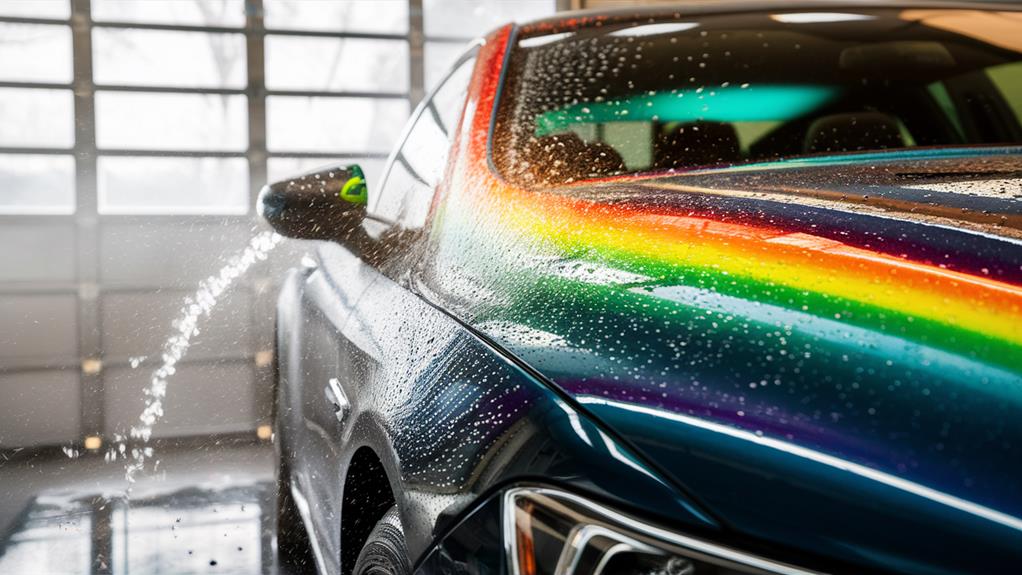
The advantages of applying a ceramic coating extend far beyond mere aesthetics, offering car owners a plethora of benefits that enhance both vehicle longevity and ease of maintenance. One of the most significant benefits is its long-term protection against various environmental contaminants. Unlike traditional wax, which requires frequent reapplication, ceramic coatings form a durable bond with the vehicle’s paint, providing years of defense against UV rays, dirt, and chemical stains.
Additionally, ceramic coatings deliver an enhanced shine that can transform a vehicle’s appearance. This glossy finish not only improves the car’s visual appeal but also makes it easier to clean. The hydrophobic properties of ceramic coatings repel water and dirt, reducing the frequency of washes and minimizing the risk of swirl marks from abrasive cleaning methods.
Moreover, car owners can enjoy peace of mind knowing that their investment is safeguarded against wear and tear. The resilience of ceramic coatings ensures that vehicles maintain their aesthetic appeal and resale value over time. In essence, ceramic coatings not only beautify vehicles but also serve as a robust shield, making them an invaluable choice for any car enthusiast.
Differences From Traditional Wax
A fundamental distinction between ceramic coatings and traditional wax lies in their composition and durability. Ceramic coatings are formulated from advanced nanotechnology, resulting in a strong, chemical-resistant layer that bonds with the vehicle’s paint. In contrast, traditional wax primarily consists of natural and synthetic waxes, providing a temporary shield that typically lasts only a few weeks. This longevity comparison highlights one of the most significant advantages of ceramic coatings.
When it comes to cost-effectiveness, while the initial investment for ceramic coatings may be higher, their durability often translates to long-term savings. Drivers won’t need to reapply as frequently, reducing both time and product costs over the years.
In terms of performance, ceramic coatings offer superior gloss enhancement, giving vehicles a brilliant shine that outlasts wax. Additionally, they provide excellent scratch resistance, protecting the paint from minor abrasions and environmental contaminants. This feature is particularly beneficial for those who frequently park outdoors or drive in harsh conditions. Overall, the differences between ceramic coatings and traditional wax reflect a shift towards more advanced, efficient methods of vehicle protection.
Application Process Overview
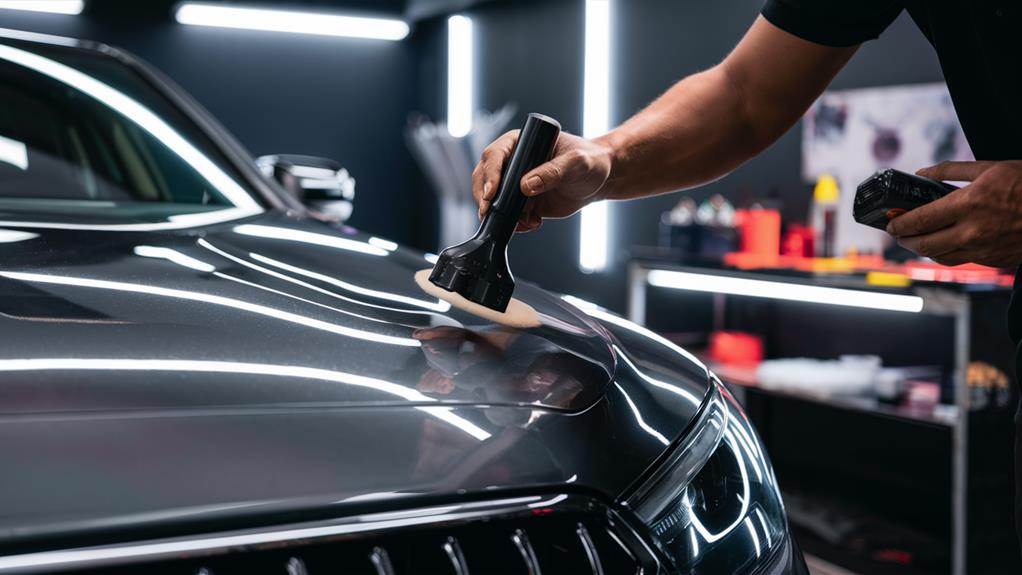
To achieve optimal results with ceramic coating, proper surface preparation is crucial. This involves thorough cleaning and decontamination to ensure the surface is free of contaminants. Once prepared, the application techniques can vary, but understanding the correct method is essential for achieving a durable and glossy finish.
Surface Preparation Steps
Before applying ceramic coating, thorough surface preparation is crucial for achieving optimal results. A well-prepared surface enhances the coating’s adhesion and durability, ensuring long-lasting protection. Here are the essential steps for effective surface preparation:
- Proper cleaning: Start by washing the vehicle with a pH-balanced car shampoo to eliminate dirt, grime, and contaminants. This step prevents impurities from interfering with the coating application.
- Decontamination: Use a clay bar to remove embedded contaminants like tree sap, tar, and industrial fallout. This process smoothens the paint surface, making it ready for the next steps.
- Paint correction: Inspect the paint for imperfections such as scratches, swirl marks, or oxidation. Utilizing a dual-action polisher with the appropriate polish compounds, correct these flaws to achieve a flawless finish.
- Final wipe-down: After paint correction, perform a final wipe with an alcohol-based solution or panel wipe to eliminate any polishing oils or residues. This ensures a clean surface for proper bonding of the ceramic coating.
Application Techniques Explained
When it comes to applying ceramic coating, mastering the right techniques can significantly impact the final outcome. First, it’s crucial to ensure the surface is perfectly clean and free of contaminants, as any imperfections can compromise adhesion. Once the surface is prepped, the application process begins.
Using a foam applicator, the technician should apply the ceramic coating in sections, allowing for controlled coverage. It’s vital to use layering techniques, as applying multiple thin layers enhances the coating’s durability and hydrophobic properties. Each layer should be allowed to flash, or partially cure, before applying the next.
Proper curing is essential to achieve optimal performance. The technician should follow the manufacturer’s guidelines, allowing the coating to cure for the recommended time before exposing it to moisture or UV light. Environmental factors, such as temperature and humidity, also play a significant role in the curing process.
Maintenance Tips for Longevity
To maximize the lifespan of ceramic coatings, a regular washing routine is essential. This helps maintain the coating’s protective properties while preventing the buildup of contaminants. Additionally, avoiding harsh chemicals will ensure that the coating remains intact and effective for years to come.
Regular Washing Routine
Maintaining a regular washing routine is essential for preserving the integrity of ceramic coatings. This practice offers numerous benefits, enhancing the coating’s longevity and overall appearance. However, there are also some drawbacks to consider. Here’s how to optimize a washing routine for vehicles with ceramic coatings:
- Frequency: Aim to wash the vehicle every two weeks to eliminate contaminants that can bond with the coating.
- Technique: Use the two-bucket method to prevent scratching. One bucket should contain soapy water, while the other holds clean rinse water.
- Tools: Invest in a high-quality microfiber wash mitt and drying towel. These tools minimize the risk of swirl marks, a common drawback of improper washing.
- Water Source: Utilize a pressure washer or a hose with a foam cannon. This method provides even coverage and reduces the need for harsh scrubbing.
While the pros of a consistent washing routine include enhanced protection and aesthetics, the cons may involve time investment. By following these maintenance tips, vehicle owners can ensure that their ceramic coatings remain effective and visually appealing for years to come.
Avoid Harsh Chemicals
Regular washing routines play a vital role in preserving ceramic coatings, but the choice of cleaning products can significantly impact their durability. Using harsh chemicals can degrade the protective layer, leading to diminished performance and longevity. Vehicle owners should be cautious and opt for gentle, pH-balanced cleaners specifically designed for ceramic coatings.
Fortunately, there are eco-friendly alternatives available that not only maintain the integrity of the coating but also protect the environment. These products often utilize plant-based ingredients, providing effective cleaning without the damaging effects of traditional chemicals.
For those inclined toward DIY solutions, creating a simple cleaning mixture at home can be both economical and effective. A blend of water, vinegar, and a few drops of mild dish soap can work wonders without harming the ceramic finish.
Ultimately, avoiding harsh chemicals ensures that the ceramic coating retains its hydrophobic properties and gloss, safeguarding the vehicle’s paint. By making informed choices about cleaning products, vehicle owners can extend the lifespan of their ceramic coatings, keeping their vehicles looking pristine for years to come.
Common Myths Debunked
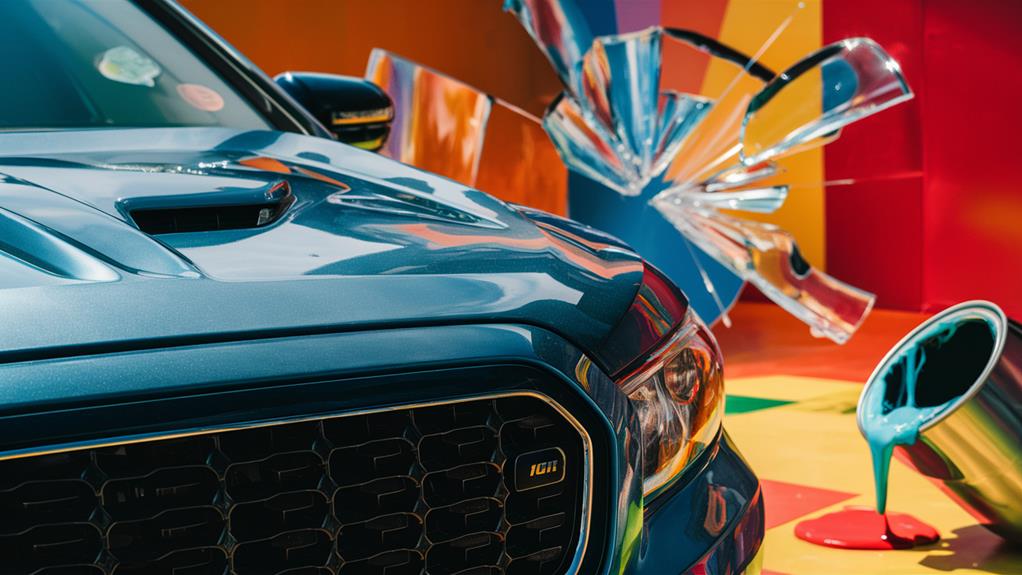
Many car enthusiasts and owners believe in a variety of misconceptions surrounding ceramic coatings. These myths can cloud their understanding of the product’s true benefits and limitations.
- Ceramic Coatings Are Scratch-Proof: While ceramic coatings enhance scratch resistance, they aren’t entirely immune. They provide a protective layer, but they can still be damaged by harsh abrasives.
- They Replace Waxing Completely: Some believe ceramic coatings eliminate the need for regular maintenance. In reality, while they offer long-term durability, occasional waxing can enhance the coating’s shine and protection.
- All Ceramic Coatings Are the Same: The effectiveness comparison among different brands and products is crucial. Not all coatings offer the same level of protection or longevity; quality varies significantly.
- They Can’t Be Applied by DIYers: Many think professional application is the only option. However, with proper research and application techniques, DIY enthusiasts can achieve satisfactory results, though professional application may ensure optimal results.
Understanding these myths helps vehicle owners make informed choices about ceramic coatings and their maintenance, ultimately leading to better long-term care for their vehicles.
Cost Considerations
When considering ceramic coatings, understanding the associated costs is essential for any vehicle owner looking to protect their investment. The pricing comparison among various products and services can be quite vast. Some coatings may range from a few hundred to several thousand dollars, depending on the brand, quality, and application method. It’s crucial to weigh the pros and cons of each option, as cheaper alternatives might not offer the same level of protection or durability.
Budget planning is another critical factor in this process. Vehicle owners should assess their financial situation and decide how much they’re willing to allocate for ceramic coating. While it may seem tempting to opt for the lowest price, investing in a higher-quality product can lead to long-term savings by reducing the frequency of maintenance and repairs.
Furthermore, professional ceramic coating application services typically add to the overall cost. However, these professionals often provide warranties and guarantees that can enhance the value of the investment. Ultimately, understanding the costs associated with ceramic coatings will empower vehicle owners to make informed decisions that align with their protection needs and financial goals.
Choosing the Right Product
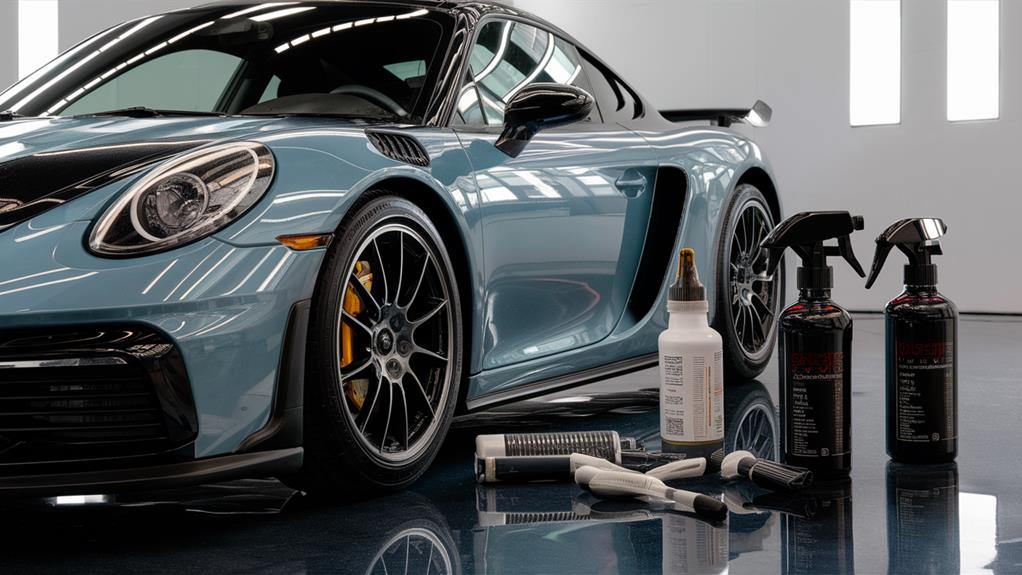
After evaluating the costs involved, selecting the right ceramic coating product becomes a pivotal next step in safeguarding a vehicle’s finish. With numerous options available, it’s essential to conduct thorough product comparisons to ensure the chosen coating meets specific needs. Buyers should consider several factors before making a decision:
- Durability: Look for coatings that offer long-lasting protection against UV rays, chemicals, and scratches.
- Ease of Application: Some products require professional installation, while others allow DIY application. Choose one that fits your skill level.
- Brand Reputation: Research brands known for quality and reliability. Established brands often provide better warranty and customer support.
- Reviews and Ratings: Investigate user experiences and feedback on different products to gauge effectiveness.
Real-Life Testimonials and Results
Regularly, car enthusiasts and everyday drivers alike share their experiences with ceramic coatings, highlighting the transformative impact these products have on their vehicles. Many customers report a significant increase in satisfaction after applying ceramic coatings, praising their long-lasting protection against scratches, UV rays, and environmental contaminants.
One customer detailed their experience by sharing striking before and after photos that showcased the incredible gloss and depth of color achieved post-application. Initially, their vehicle appeared dull and faded, but the ceramic coating revitalized the paint, making it look brand new.
Another user emphasized ease of maintenance, noting that washing their car became a breeze. The hydrophobic properties of the coating allowed water to bead and slide off, minimizing dirt accumulation and reducing cleaning time.
These testimonials frequently highlight the durability of ceramic coatings, with many users confirming that their vehicles maintain a pristine appearance for years. Overall, the real-life results speak volumes, illustrating that ceramic coatings not only enhance aesthetics but also provide unparalleled protection, leading to high levels of customer satisfaction and a remarkable transformation in how vehicles are cared for.
Frequently Asked Questions
Can Ceramic Coating Be Applied to All Vehicle Surfaces?
Yes, ceramic coating can be applied to most vehicle surfaces. It offers glass protection and enhances durability. Additionally, wheel application provides extra defense against brake dust and road grime, ensuring a long-lasting, pristine finish.
How Long Does Ceramic Coating Last Before Reapplication?
When considering how long ceramic coating lasts, one should note its durability typically ranges from two to five years. Regular maintenance enhances benefits, but the cost of reapplication varies based on product quality and application method.
Is Ceramic Coating Safe for Painted Surfaces?
Ceramic coating’s safe for painted surfaces, enhancing paint protection while ensuring longevity. It bonds with the paint, creating a durable shield against environmental damage, making it an excellent choice for vehicle maintenance and aesthetics.
Can DIY Ceramic Coating Products Deliver Professional Results?
Many believe DIY ceramic coating products can rival professional applications, but the reality’s mixed. While some users report impressive consumer satisfaction, achieving the same durability and finish as experts often requires skill and experience.
Does Ceramic Coating Protect Against Scratches and Chips?
Ceramic coating offers enhanced durability, significantly improving a vehicle’s resistance to scratches and chips. While it can’t guarantee complete scratch prevention, it creates a protective layer that helps minimize damage from everyday wear and tear.
Conclusion
In conclusion, while some may worry that ceramic coating is just another expense, the long-term protection and value it brings to a vehicle far outweigh the initial cost. Imagine the peace of mind knowing your car is shielded from environmental damage and everyday wear. With its impressive durability and ease of maintenance, ceramic coating transforms vehicle care into a hassle-free experience, allowing owners to enjoy their prized possessions with confidence and pride for years to come.

